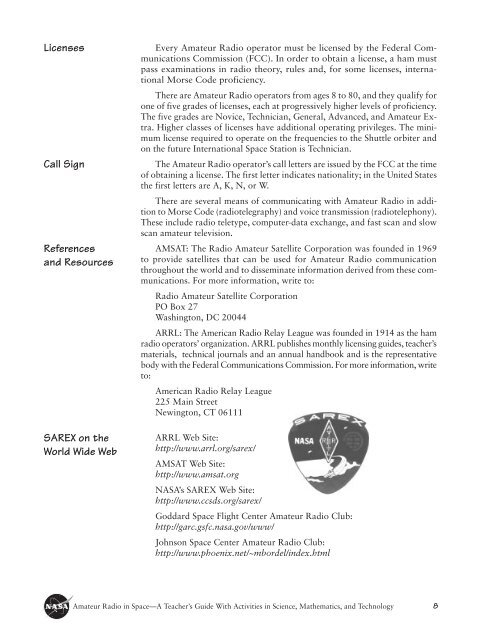Amateur Radio in Space - ER - NASA
Amateur Radio in Space - ER - NASA
Amateur Radio in Space - ER - NASA
- No tags were found...
Create successful ePaper yourself
Turn your PDF publications into a flip-book with our unique Google optimized e-Paper software.
LicensesCall SignReferencesand ResourcesSAREX on theWorld Wide WebEvery <strong>Amateur</strong> <strong>Radio</strong> operator must be licensed by the Federal CommunicationsCommission (FCC). In order to obta<strong>in</strong> a license, a ham mustpass exam<strong>in</strong>ations <strong>in</strong> radio theory, rules and, for some licenses, <strong>in</strong>ternationalMorse Code proficiency.There are <strong>Amateur</strong> <strong>Radio</strong> operators from ages 8 to 80, and they qualify forone of five grades of licenses, each at progressively higher levels of proficiency.The five grades are Novice, Technician, General, Advanced, and <strong>Amateur</strong> Extra.Higher classes of licenses have additional operat<strong>in</strong>g privileges. The m<strong>in</strong>imumlicense required to operate on the frequencies to the Shuttle orbiter andon the future International <strong>Space</strong> Station is Technician.The <strong>Amateur</strong> <strong>Radio</strong> operator’s call letters are issued by the FCC at the timeof obta<strong>in</strong><strong>in</strong>g a license. The first letter <strong>in</strong>dicates nationality; <strong>in</strong> the United Statesthe first letters are A, K, N, or W.There are several means of communicat<strong>in</strong>g with <strong>Amateur</strong> <strong>Radio</strong> <strong>in</strong> additionto Morse Code (radiotelegraphy) and voice transmission (radiotelephony).These <strong>in</strong>clude radio teletype, computer-data exchange, and fast scan and slowscan amateur television.AMSAT: The <strong>Radio</strong> <strong>Amateur</strong> Satellite Corporation was founded <strong>in</strong> 1969to provide satellites that can be used for <strong>Amateur</strong> <strong>Radio</strong> communicationthroughout the world and to dissem<strong>in</strong>ate <strong>in</strong>formation derived from these communications.For more <strong>in</strong>formation, write to:<strong>Radio</strong> <strong>Amateur</strong> Satellite CorporationPO Box 27Wash<strong>in</strong>gton, DC 20044ARRL: The American <strong>Radio</strong> Relay League was founded <strong>in</strong> 1914 as the hamradio operators’ organization. ARRL publishes monthly licens<strong>in</strong>g guides, teacher’smaterials, technical journals and an annual handbook and is the representativebody with the Federal Communications Commission. For more <strong>in</strong>formation, writeto:American <strong>Radio</strong> Relay League225 Ma<strong>in</strong> StreetNew<strong>in</strong>gton, CT 06111ARRL Web Site:http://www.arrl.org/sarex/AMSAT Web Site:http://www.amsat.org<strong>NASA</strong>’s SAREX Web Site:http://www.ccsds.org/sarex/Goddard <strong>Space</strong> Flight Center <strong>Amateur</strong> <strong>Radio</strong> Club:http://garc.gsfc.nasa.gov/www/Johnson <strong>Space</strong> Center <strong>Amateur</strong> <strong>Radio</strong> Club:http://www.phoenix.net/~mbordel/<strong>in</strong>dex.html<strong>Amateur</strong> <strong>Radio</strong> <strong>in</strong> <strong>Space</strong>—A Teacher’s Guide With Activities <strong>in</strong> Science, Mathematics, and Technology 8
















